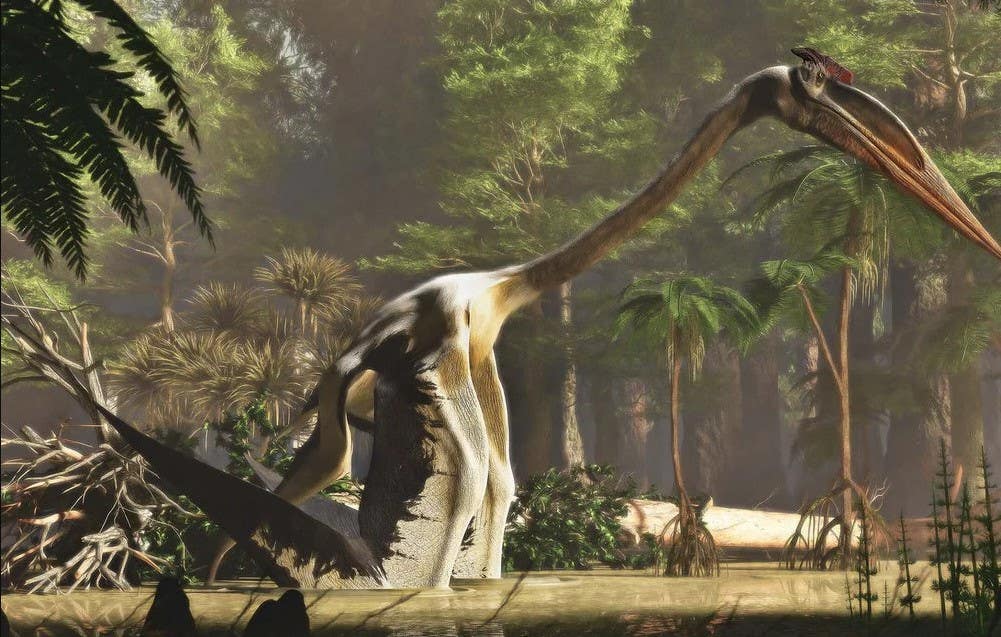What the new Jurassic Park movie gets wrong about dinosaurs
One of the most exciting moments of the new Jurassic Park sequel, Jurassic World Dominion, is when Quetzalcoatlus swoops down from the sky.

[May 22, 2022: Matthew Coslett, Nagoya University]
A fateful day some 66 million years ago, a 7.5-mile-wide (12 kilometer) space rock slams into Earth. (CREDIT: Creative Commons)
One of the most exciting moments of the new Jurassic Park sequel, Jurassic World Dominion, is when the Quetzalcoatlus swoops down from the sky and attacks the heroes’ aircraft. With its gigantic wings that reach 10 meters in length when spread end to end, the Quetzalcoatlus was the largest pterosaur that ever existed. However, an aerodynamic analysis led by researchers from Nagoya University suggests that Jurassic World Dominion gets it wrong. In fact, these giant creatures would have been unable to fly for anything more than a short distance.
To make this surprising discovery, the group consisting of Yusuke Goto and Ken Yoda of the Graduate School of Environmental Studies, Nagoya University, in collaboration with the University of Tokyo, and the CEBC in France, calculated and compared the ability of extinct giant flying creatures and modern birds to soar using wind and air currents in an energy-efficient way.
There are two types of soaring: thermal soaring, which uses updrafts to ascend and glide, such as eagles and frigatebirds; and dynamic soaring, which uses wind gradients over the ocean, as in the case of albatrosses and petrels. Using a model, the group calculated the performance of thermal and dynamic soaring for four species of extinct flying giant creatures and compared it to the performance of present-day birds. They found that the famous Pteranodon of Jurassic Park III fame, for example, likely excelled at soaring flight using updrafts over the sea, flying in a similar way to the modern frigatebirds.
However, when they investigated the Quetzalcoatlus, the largest flying animal to have ever lived, they found that it was not suited for soaring flight even when atmospheric density parameters were changed.
Related Stories
“The poor thermal and slope soaring performance of Quetzalcoatlus was due to the large wing loading associated with their large body size,” the researchers say. “This suggests that the wind conditions under which Quetzalcoatlus could conduct sustainable thermal soaring were limited. Although it had previously been thought that Quetzalcoatlus was a proficient thermal soarer able to cover 10,000 miles without touching the ground, our studies show that its thermal soaring abilities were below that of modern birds. We suppose that the flight styles of Quetzalcoatlus and other similar sized pterosaurs were similar to those of the kori bustard that is a short-range flyer and spend most of their time on land.”
As well as the pterosaurs, the group also looked at two extinct giant birds, Argentavis magnificens, the heaviest flying bird that ever existed, and Pelagornis sandersi, which has the largest wingspan of any flying bird. Here too, the group made a surprising discovery. On the one hand, their results agreed with previous studies that Argentavis was suited to thermal soaring; on the other hand, they found that Pelagornis was suited to thermal soaring, although it was previously thought to use dynamic soaring.
Although it is too late for Jurassic World Dominion, the results of the study will likely change the way extinct giant birds and pterosaurs are portrayed in the inevitable sequels.
For more science stories check out our New Discoveries section at The Brighter Side of News.
Note: Materials provided above by Nagoya University under a Creative Commons license. Content may be edited for style and length.
Like these kind of feel good stories? Get the Brighter Side of News' newsletter.
Tags: #New_Discoveries, #Quetzalcoatlus, #Dinosaurs, #Movies, #Fossils, #Archeology, #Global_Good_News, #Celebrities, #Science, #Research, #The_Brighter_Side_of_News
Joseph Shavit
Head Science News Writer | Communicating Innovation & Discovery
Based in Los Angeles, Joseph Shavit is an accomplished science journalist, head science news writer and co-founder at The Brighter Side of News, where he translates cutting-edge discoveries into compelling stories for a broad audience. With a strong background spanning science, business, product management, media leadership, and entrepreneurship, Joseph brings a unique perspective to science communication. His expertise allows him to uncover the intersection of technological advancements and market potential, shedding light on how groundbreaking research evolves into transformative products and industries.



